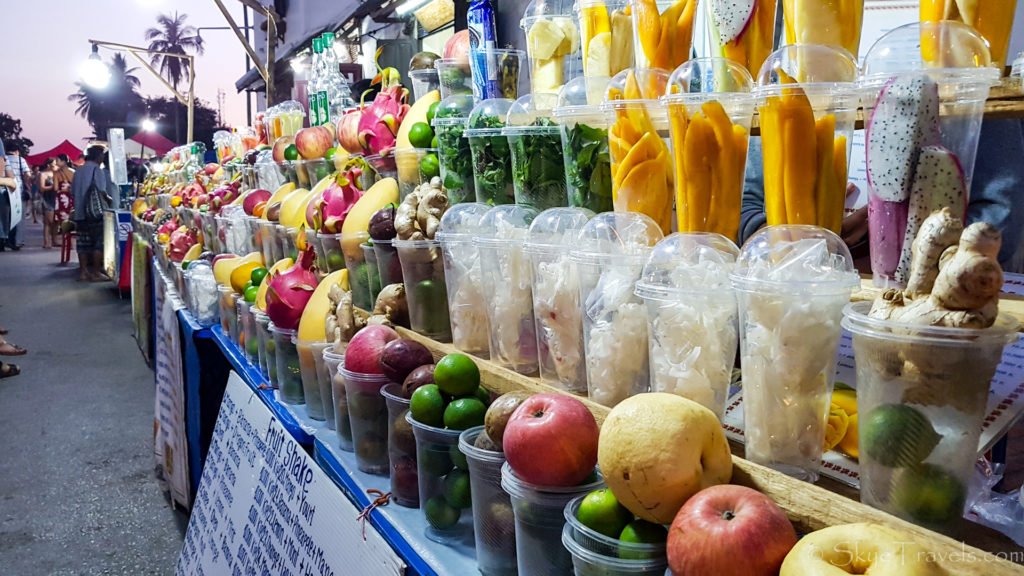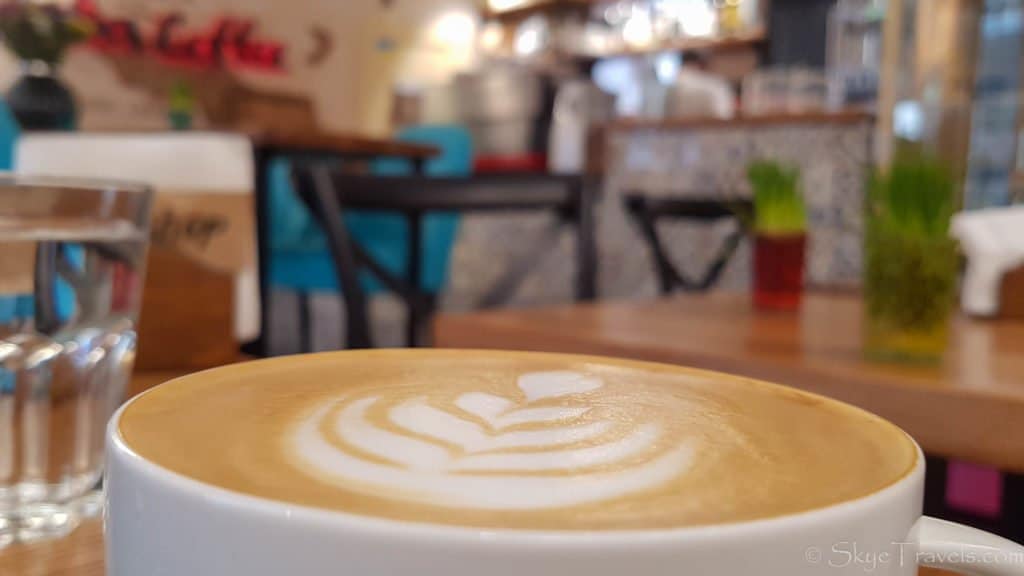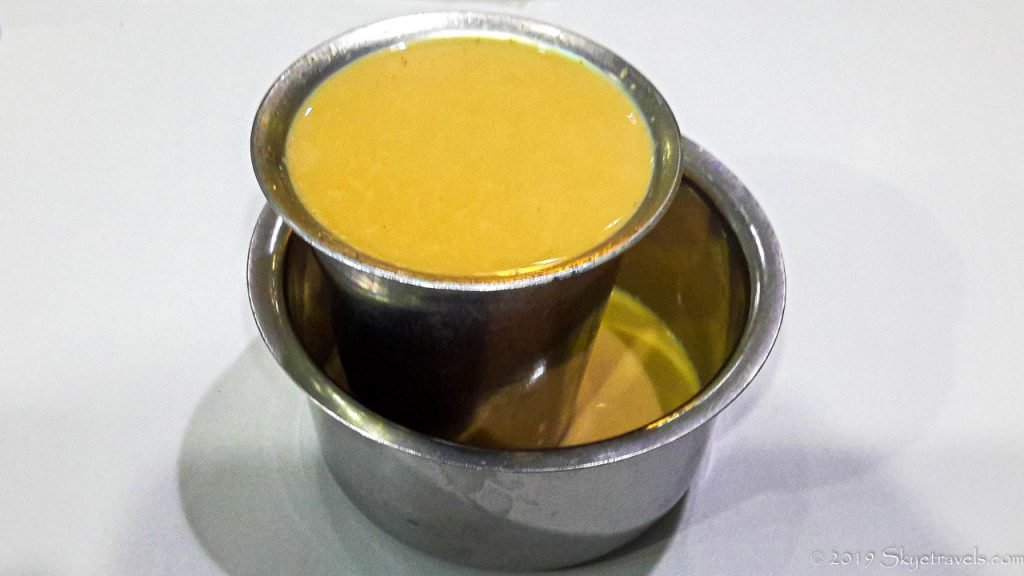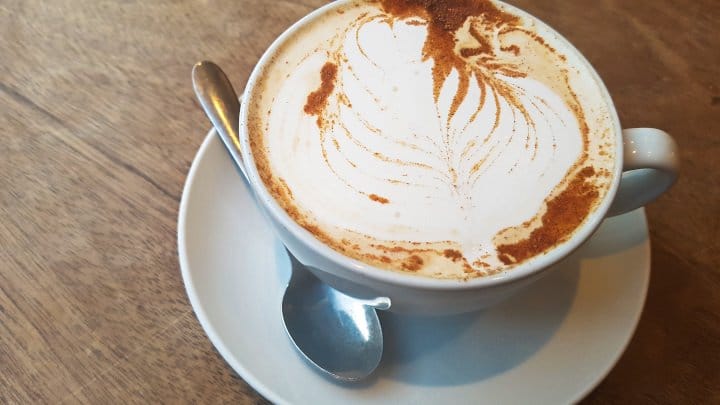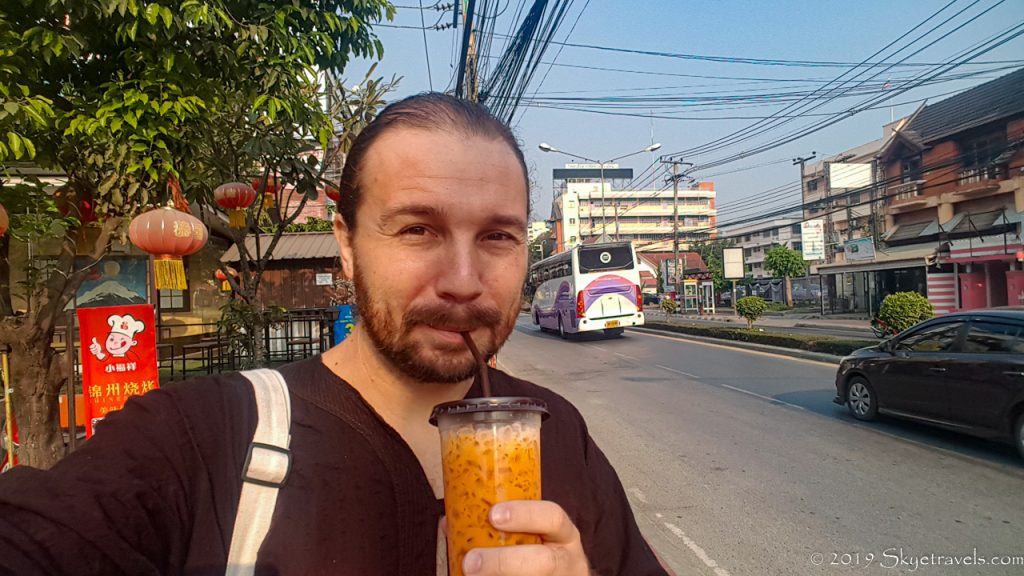You probably know by now that I’m not a big drinker. I say I drink when I have to, and that’s not often. Thus, I’m always on the lookout for the best non-alcoholic drinks around the world to enjoy when I’m traveling.
Smoothies and Juices
These two go without saying and are available in nearly every part of the world. I’m particularly fond of the juices and smoothies in southeast Asia. Not only are they often prepared fresh in front of you, they’re also very cheap. Some of my favorite juice bars in Chiang Mai, Thailand sell a large smoothie for less than $1. You just have to make sure you ask for “no sugar”, as they love to add a thick sugar water.
Another country that stands out for its juices is Romania – particularly the lemonades. In Timisoara, Romania, they offer well over a dozen flavors of lemonade, all made with fresh fruit or other ingredients. Peach, blueberry, and pineapple were my favorites. I purchased quite a few on the hot days I was there back in 2015, especially since they were also about $1 each.
In some places, the juice scene is just starting to catch on. I was surprised to see how long it took Edinburgh to open a few juice bars. In the past couple years, Hula Juice Bar opened a couple shops, but otherwise, I used to get my smoothies from Black Medicine Coffee…which I still think makes the best fruit drinks in town.
Third Wave Coffee
On the subject of coffee, I’m doing everything in my power not to be addicted. That’s extremely hard when I’m based in Edinburgh, which has some of the best cafes anywhere. That the city where I learned what third wave coffee is, but this hipster version of coffee isn’t just available in Edinburgh.
In a nutshell, third wave coffee isn’t Folgers pre-ground instant coffee (first wave), nor mass-produce single-origin coffee like Starbucks (second wave). Wikipedia defines third wave coffee well by saying, “Distinct from the first two waves, the third wave of coffee disrupts the more commodity-focused trade of coffee and prioritizes taste quality, unique flavors, and equitable relationships over low prices and standardizations in flavor.”
Many of the backpacker and hipster hubs around the world have several cafes serving this type of coffee. In Bucharest, Romania I enjoyed several cups at Origo Cafe. In Chiang Mai, it was Ristr8to Lab, Akha Ama la Fattoria, and SS1254372 Cafe. While staying in Rotterdam this summer, my favorite cafe to visit was Bagels & Beans where they get all their coffee from a small family-run plantation in Panama.
If you do happen to make it to Edinburgh, there are almost too many cafes to choose from. My favorites include Castello Coffee, Black Medicine Coffee, Machina Expresso, Fortitude Coffee, Wellingtons and Cult Espresso. I used to like Brew Lab, but they were recently bought out by the London-based company Union, and it just doesn’t feel the same anymore there. I’ll have to get a full post out soon on all these cafes.
Kombucha
The first time I had kombucha was at By Hand Pizzeria in Chiang Mai, Thailand. I’ve tried it a couple more times since then, such as at Frenchie’s Cafe in Haarlem, Netherlands. This is the only fermented (and slightly alcoholic) beverage I have on my list, although the alcoholic content is usually about 0.5%. I certainly don’t drink it for the alcohol or even health benefits, but rather for the unique taste. I’ve heard it’s become more popular in the States since I left. I’d recommend trying it if you happen to run across it at a cafe or restaurant in your travels.
Indian Chai
When I watched Slumdog Millionaire when it came out in 2008, I was stumped at what a chai wallah was. Googling it, I learned a wallah is a person who makes and/or sells a commodity. Chai is the Indian word for tea, but not in the sense that we think of tea (a tea bag in a cup of hot water). While they use black tea leaves as a base, this is then mixed with ginger, cardamom, cloves, cinnamon, black pepper and other spices.
This is quite different from the Chai tea lattes I’ve been purchasing from cafes since long before I started traveling. While those are enjoyable, they’re usually made from a powder. I haven’t been to India yet, but I’ve been to Little India, a neighborhood in Kuala Lumpur, Malaysia. There, I visited a hole in the wall restaurant where they placed a large banana leaf on the table and then spooned rice and curry directly on to the leaf to eat with your fingers. I ordered a chai, which came in two small vessels – a small steel cup inside a bowl to catch the spills. This was nothing like the bastardized cafe drink popularized by Starbucks in the late 90s; it was so much better!
Since then, I’ve found a handful of Indian restaurants around the world that serve a chai that’s up to par. One was 10 to 10 Dehli in Edinburgh. I always ask restaurants if their chai is homemade, although I’ll still probably get it if it isn’t. I’ll even order the Chai latte more often than not when I see that a cafe is serving one.
Thai Tea
I didn’t try Thai tea before my first visit to Thailand. Now I can’t stop drinking it, and I even have the ingredients to make it at home in the UK. Some people refer to it as orange tea. It’s a special blend of black tea which turns orange when it’s mixed with sweetened condensed milk. It’s almost always served over ice, and couldn’t be more delicious in the hot weather of Thailand.
If you want to make this at home, you can order the tea leaves online. The name is in Thai, but in English, the package says “Number One Brand” with red and gold packaging. In the US and UK, I use Carnation sweetened condensed milk, and I usually put in a little less than the recommended amount of sugar. There are a bunch of Youtube videos that show how to make Thai tea correctly.
Mexican Horchata
Horchata can refer to several different beverages produced in Central and South America and in Africa. The variety I’m familiar with is horchata de arroz from Mexico, made with rice milk. As with many of these drinks, the best horchata I found in Mexico City was at street vendors. Not every Mexican restaurant has the drink available; I’ve actually had a hard time finding it around the world outside Mexico, but I can always look forward to it when I’m back in Latin America.
Moroccan Mint Tea
Mint tea is obviously available in far more places than just Morocco. It’s one of the most popular beverages in Korea (per my English students) and I had some delicious cups in Turkey, but the Moroccan blend really stood out for me. The Moroccan version is correctly known as Maghrebi mint tea. It’s more than simply a drink in Morocco. Just like vodka is part of the bonding process in Russia, Moroccans use mint tea ceremoniously when welcoming guests.
My favorite part about Moroccan mint tea (aside from the delicious taste) is the presentation. In order to create the bubbles in the cup, the tea is poured from high, sometimes several feet in the air. It’s always fun to watch servers pour with perfect accuracy. Just give it a second to cool down. The glasses rarely have handles and they can be really hot!
Vietnamese Egg Coffee
I’d never heard of egg coffee before I landed in Hanoi, the capital of Vietnam. On my first day walking through the city, I saw a cafe advertising it and thought it was perhaps a joke. Intrigued, I ordered a cup. It was delicious! It was as if someone had topped a really good espresso with a large dollop of custard cream. Well, that’s exactly what it is.
A couple days later, I joined a local food tour where I got to learn the real scoop on Cà Phê Trứng (Vietnamese for egg coffee). It was started in 1946 by a guy named Nguyen Giang. While thousands of cafes have tried to copy his legendary drink over the years, he keeps his recipe highly guarded and it tastes truly unique. I know this as the tour took us to the original cafe where he served egg coffee. That cafe, called Cafe Giang, is now managed by his son, while a second cafe in the center of town, Café Đinh, is managed by his daughter. They stick to the original recipe and, although the price might have risen over the years, a cup of egg coffee will only set you back $0.65!
Malaysian Iced Cham
This next one is super unique, and probably an acquired taste for most. Iced cham is a mixture of coffee and tea in proper ratio. That might sound crazy, but I found it surprisingly good. It was really refreshing, especially considering how hot Kuala Lumpur was when I visited. I’ve heard this drink is also available in Hong Kong under the name yuenyeung, and in Ethiopia where it’s called spreeze. If you find yourself in any of these locations, I’d recommend trying out a cup for yourself. Maybe you won’t like it, but maybe you will.
Kompot
Finally, I have to mention kompot (or compot as some countries spell it). This drink is served throughout much of Europe and Asia. It’s made by cooking fruit (such as strawberries, peaches, cherries, or many others) in large quantities of water, mixed with sugar or raisins, and sometimes spiced. It’s never brewed to the point where it develops alcohol. Some countries have started serving juice more than kompot, as this drink stems from the days when food was rationed out and fruit was received in limited quantities.
I first ran across kompot in Odessa, Ukraine (one of the countries where it’s still very popular). A couple years later, I had a glass on my food tour in Krakow, Poland. Granted, I’d probably go for juice over kompot if it’s available, as kompot is sometimes a bit watery. However, I still really like the flavor and grab a glass now and then when I see it.
Bonus: My Special Drink
There’s one more drink worth mentioning, but not something I’ve ever found while traveling the world. It’s a concoction I had as a child, made by my healthy parents, and I continued to use it often when I lived in Los Angeles where I needed electrolyte boosts to combat the heat.
My special drink is made primarily with honey, lemon juice and apple cider vinegar. All three of these ingredients have huge benefits. While I’m not a doctor or nutritionist, I’ve felt much healthier when making this drink on a regular basis. If I’m feeling a little sick, I’ll also add a bit of cayenne pepper, or some powdered ginger if it’s hot outside. Similarly, I’ll serve it hot in the cold months, and over ice in the summer.
As to the proportions, it’s completely based on taste. I like my apple cider vinegar strong, and I use the Bragg brand if I can find it. This isn’t medical advice, but I’d say you’d need at least a teaspoon of ACV per glass. If that seems strong to you, just increase the lemon juice and honey to neutralize the kick.
View this post on Instagram
One More Thing
If you know another non-alcoholic drink around the world that I need to try, please let me know so I can make sure to get them when I’m in their respective countries.
Click to Pin It
Further Reading
Here’s some extra reading to save hundreds on your next vacation or stage of your journey.
- 5 Steps to Book Cheap Flights
- Hostels: To Book or Not to Book
- Is Workaway Worth it for the Traveler?
- Click here to claim your $25 credit with AirB&B
This post may contain affiliate links. These links help give me the wherewithal to continue traveling at no additional cost to you. For more information, click here.


